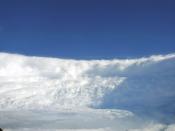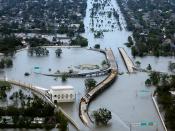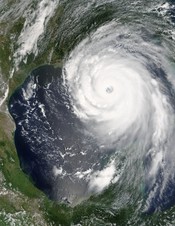Hurricane Katrina was the eleventh named tropical storm, fourth hurricane, third major hurricane, and first Category 5 hurricane of the 2005 Atlantic hurricane season. It was the third most powerful storm of the season, behind Hurricane Wilma and Hurricane Rita, and the sixth-strongest storm ever recorded in the Atlantic basin. It first made landfall as a Category 1 hurricane just north of Miami, Florida on August 25, 2005, then again on August 29 along the Central Gulf Coast near Buras-Triumph, Louisiana as a Category 4 storm. Its storm surge soon breached the levee system that protected New Orleans from Lake Pontchartrain and the Mississippi River. Most of the city was subsequently flooded mainly by water from the lake. This and other major damage to the coastal regions of Louisiana, Mississippi, and Alabama made Katrina the most destructive and costliest natural disaster in the history of the United States.
The official death toll now stands at 1,322 and the damage from $70 to $130 billion, topping Hurricane Andrew as the most expensive natural disaster in U.S.
history. Over a million people were displaced -- a humanitarian crisis on a scale unseen in the U.S. since the Great Depression.
In Louisiana, the hurricane's eye made landfall at 6:10am CDT on Monday, August 29. After 11:00am CDT, several sections of the levee system in New Orleans collapsed. By early September, people were being forcibly evacuated, mostly by bus to neighboring states.
Federal disaster declarations blanketed 90,000 square miles (233,000 km") of the United States, an area almost as large as the United Kingdom. The hurricane left an estimated five million people without power, and it may take up to two months for all power to be restored. On September 3, Homeland Security Secretary Michael Chertoff described the aftermath of Hurricane Katrina as...


